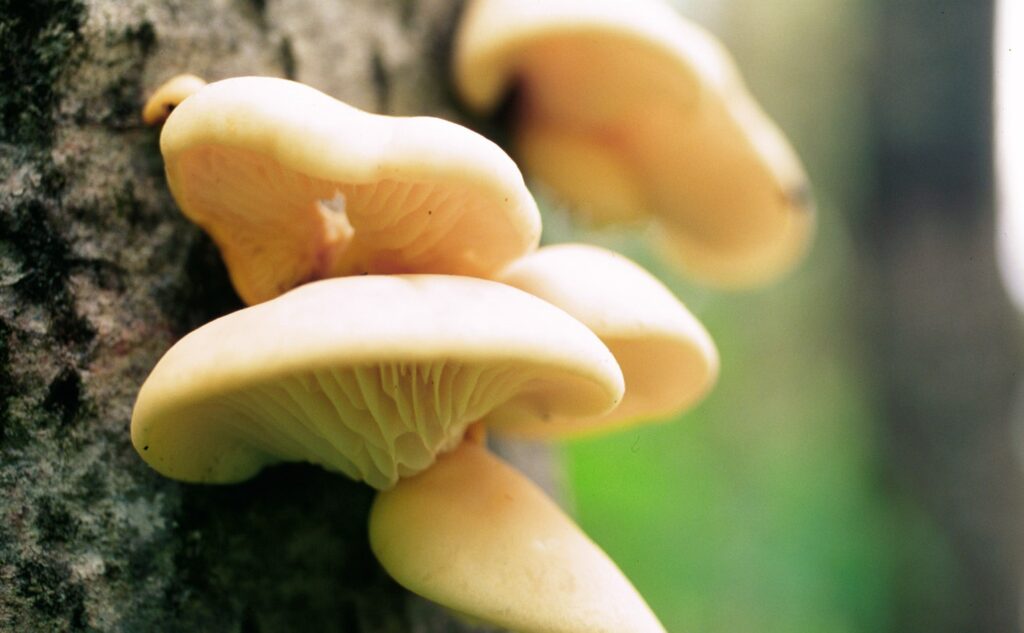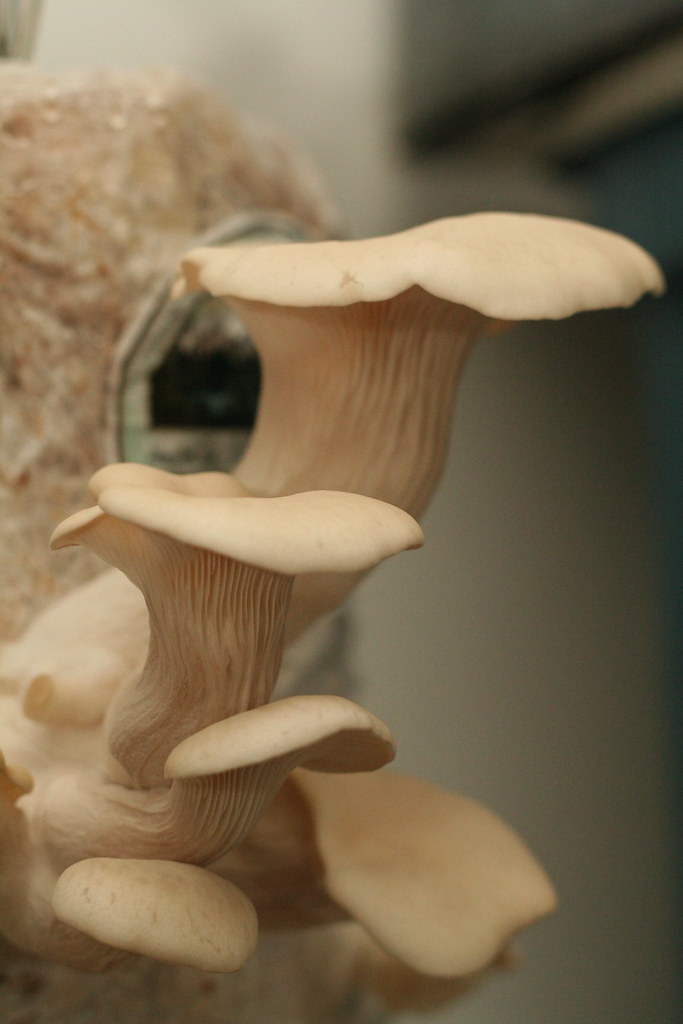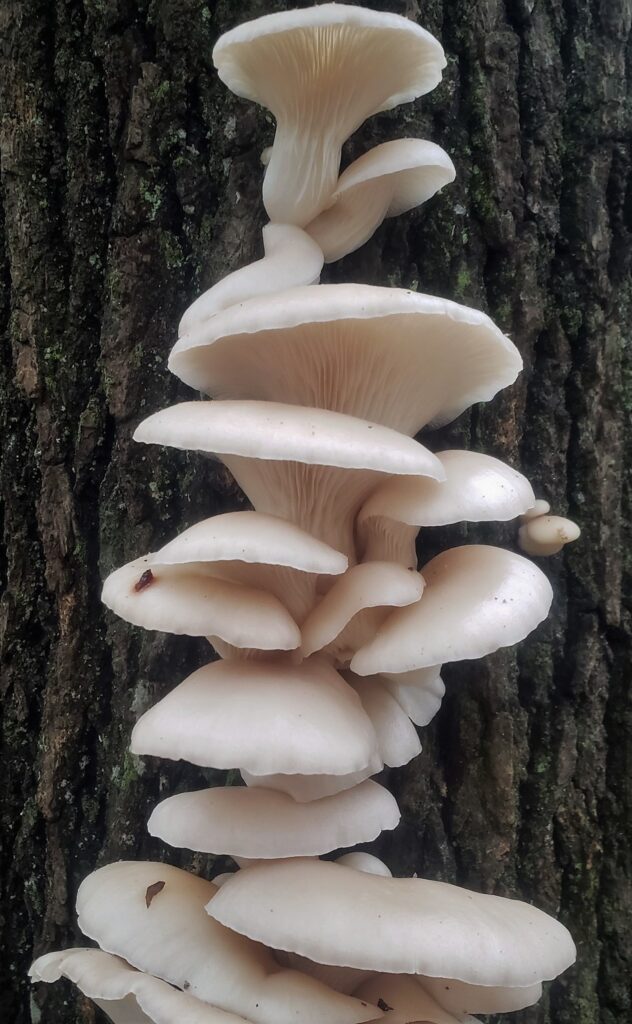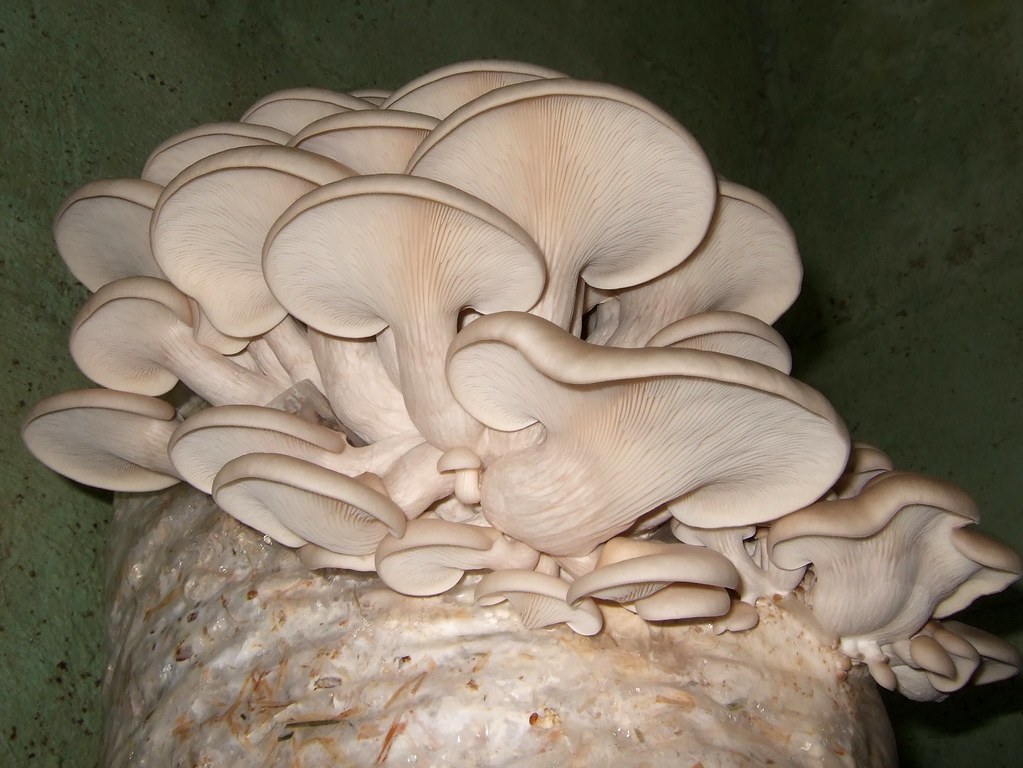The pearl Oyster Mushrooms are the most famous among the Oyster Mushroom family. They are easy to cultivate and can be easily grown at home. In this article, you will learn about Pearl Oyster Mushrooms, how they grow, the nutrients present in them, their health benefits, and much more. Let’s jump in…
Pearl Oyster Mushroom (Pleurotus ostreatus)
Pearl Oyster Mushroom i.e. Pleurotus ostreatus is a commonly sought wild edible mushroom variety. Though it is found in the wild it can be easily cultivated using cultured spawn on paddy straw or any other media. They are generally found in clusters on dead trees.
The Oyster mushrooms have a broad oyster-shaped cap spanning 5-25 centimeters. The mushroom got its name from its oyster-shaped cap, its slippery texture, and the color of its gills which is cream to white. The mushroom has a bitter-sweet aroma.
Interestingly Pearl Oyster Mushrooms are among the few known carnivorous mushrooms and they prey on nematods from which they get the nitrogen required for their growth. They can be easily found in temperate and subtropical regions of the world.
One of the interesting facts about oyster mushrooms is that they can bio-accumulate lithium. They also have nutritional and medicinal properties which we will discuss later in this article. Now the question that came to mind is how can we identify the Pearl Oyster Mushrooms?

Pearl Oyster Mushroom Identification
The mushroom could be identified using the following information
- Cap: The cap of the mushroom is oyster-like fan-shaped which varies from 5 cm to 25 cm. The cap is smooth without any warts and its color usually varies from White to Cream. The gills of the mushroom are attached to its stem.
- Stem: They may or may not have a stem. Its gills ran from the cap to the stem.
- Habitat: They are saprotrophs i.e. they are primary decomposers and feed on dying wood.
- Smell: The oyster mushrooms have a little sweet smell.
Are there any toxic Pearl Oyster Mushroom Look Alike?
While identifying the Pearl Oyster Mushrooms in the wild one should be cautious and should ensure that the mushrooms do not look alike. The toxic Look-alike, Omphalotus Nidiformis, is poisonous and is commonly found in Japan and Australia.

Pearl Oyster Mushroom Benefits
Pearl Oyster Mushrooms have various health benefits. These mushrooms are full of nutrients and are very low in calories. They carry just 33 Kcal for every 100 grams. The protein content in oyster mushrooms is 3.31g per 100 grams. Thus they are a good source of protein for vegetarians and vegans.
Oyster mushrooms’ regular consumption also helps to control high cholesterol levels and it also lowers the risk of heart disease. They are also loaded with antioxidants, essential minerals, vitamins, and other natural bioactive compounds essential for healthy life.
These mushrooms produce beta-glucan which is anti-allergic and also has anti-viral properties. Certain proteins that are present in the mushrooms are found to have anti-hyperglycemic, anti-inflammatory, anti-soft tissue tumor, and anti-hypertensive effects.
Based on some studies on animals like mice and rats it was shown that the consumption of oyster mushrooms has resulted in the reduction of the size of tumors. One could incorporate oyster mushrooms in their diet to get the benefits or they are also available in capsule form.
Nutrient Content of Pearl Oyster Mushrooms
Macro Nutrients present in Pearl Oyster Mushrooms are (Per 100 grams)
| Energy | 33Kcal | 1.6% |
| Carbohydrates | 6.09g | 4.7% |
| Proteins | 3.31g | 6% |
| Total Fat | 0.41g | 2% |
| Dietary Fiber | 2.3g | 6% |
| Folates | 38ug | 9.5% |
| Niacin | 4.956mg | 31% |
| Pantothenic acid | 1.294 mg | 26% |
| Pyridoxine | 0.110 mg | 8% |
| Riboflavin | 0.349 mg | 27% |
| Thiamin | 0.125mg | 10% |
| Vitamin-D | 29 IU mg | 7% |
| Sodium | 18 mg | 1% |
| Potassium | 420 mg | 9% |
| Calcium | 3 mg | <1% |
| Copper | 0.244 mg | 27% |
| Iron | 1.33 mg | 16.5% |
| Magnesium | 18 mg | 4.5% |
| Manganese | 0.113 mg | 5% |
| Phosphorous | 120 mg | 17% |
| Selenium | 2.6ug | 5% |
| Zinc | 0.77 mg | 7% |

Pearl Oyster Mushroom growing condition
How to grow Pearl Oyster Mushroom at home? If this question comes to your mind then we will in this section how you can grow Pearl Oyster Mushrooms at your home.
Like other strains of edible mushrooms Pearls Oyster mushrooms can be grown at home. One can buy the Oyster mushrooms growing kit which will provide all the materials for the cultivation of mushrooms.
Now we will see how to grow oyster mushrooms at home. The steps involved are
1. Good quality spawn
Firstly to grow good quality oyster mushrooms you have to get good quality Pearl Oyster Mushroom spawn. One could buy them from the market.
2. Choosing the substrate for their growth
Substrate for mushrooms can be understood as soil for plants. It provides the required nutrients for the growth of mushroom mycelium. Paddy straw is a good substrate for the Oyster Mushrooms which provides the optimal C/N ratio for the growth of oyster mushrooms.
Other substrate materials are wheat straw, sugarcane bagasse, rubber tree sawdust, cotton waste, coco lumber sawdust, coffee pulp, coir, and others. In choosing the substrate one should consider its availability, expenses, and productivity of the substrate.
3. Preparation of substrate
The paddy straw substrate is soaked in water for about 24 hours so that it achieves 65-75% moisture. Now remove the excess water from the substrate and boil the substrate at 100C for 1 hour.
Boiling the substrate will kill the unwanted microbes and sterilize the substrate. After boiling the substrate carefully remove it and dry it till it contains only 5% moisture content.
Now your substrate is ready for cultivation of mushroom at home. For cultivation, you will need polypropylene bags which come with a Pearl oyster Mushroom kit or you could also get them separately from the market. Bag cultivation is the most widely performed method as it provides stable growth.

4. Spawning of Oyster Mushroom
Before filling the bag with spawn and substrate make sure that your hands are clean or use gloves so that no microbes get in the bag.
Firstly a layer of the substrate as prepared above is taken in the bag. After that cautiously spread the spawn on the outer side of the substrate. Now repeat this spawning process several times in the same manner.
Once the bag is full now close the bag using rubber bands or clips. Make some small holes using a needle in the side of the bag. Don’t make holes in the bottom of the bag as it may be contaminated by the microbes.
5. Cultivation room environment
The room for the cultivation of Pearl Oyster Mushrooms should be properly cleaned and sterilized using 10% formaldehyde solution. You could use shelves for keeping the bags or using rope you could hang the mushroom bags one over other at optimum temperature and humidity.
Pearl Oyster Mushroom Incubation
The oyster mushrooms can grow between 10-30 Celsius but the optimum temperature is 22-26 Celsius. Higher temperatures inhibit the growth and can kill the mycelium. Thus it is important to maintain optimum temperature in the room for effective yield.
The CO2 concentration in the room should be within 15-20%. During the mycelia growth ensure that the bags are not opened as ventilation is not required at this stage.
After the incubation period first check whether there is any contaminated bag. If present then discard the contaminated bag.
Pearl Oyster Mushroom pinning
Once the mycelium has fully colonized the substrate it is ready for pinning. Pinning involves worsening the environmental condition so that mycelia cannot keep the vegetative growth and thus convert to the reproductive growth mode, which initiates fruitbody formation.
Fruiting Stage of Pearl Oyster Mushrooms
The conditions that are required for the fruiting are
Temperature
The temperature during the growing period not only affects the yield but also affects the quality of the mushroom produced. The optimal temperature for oyster mushroom growth is 22-26 Celsius.
Relative Humidity
During the fruiting period, the relative humidity should be maintained between 75-85%. To maintain this humidity water spraying is to be done on a regular basis or you could use humidifier. There should be proper ventilation in the room and an exhaust fan can be used to maintain the humidity level.
CO2
The CO2 level should be less than 600 ppm during the fruiting period. Thus proper ventilation is required. High concentrations of CO2 will drastically affect the yield and also the quality of the mushrooms.

When to harvest Pearl Oyster Mushroom
Generally, the pinheads turned into mushroom-like structures in 32-35 days. The first harvest of your Pearl Oyster Mushrooms is ready in about 36-45 days.
It is important to pick your oyster mushrooms at the right time otherwise they will overgrow and lose their quality.
The right time to start picking your mushroom can be judged by observing the cap and the cap margins of the mushrooms. If the cap of the mushroom is flat and the inward curling of the cap has started then it is a sign that your mushroom has matured and is ready to be harvested.
You could use a knife or scissors to pick your mushrooms from the bag. After the first harvest, the second harvest will be ready within 2-3 days.
Things to keep in mind for maximum yield of oyster mushrooms
- The temperature should be maintained within the range of 22-26 Celsius.
- The humidity should be in the range of 75-85% during the fruiting period.
- There should be proper ventilation in the room where mushrooms are growing.
- The CO2 level should be less than 600 ppm inside the room.
To conclude, the Pearl Oyster Mushroom has numerous health benefits, and being low in calories is packed with loads of nutrients, vitamins, and antioxidants one should definitely include them in one diet.
FAQs
Q. Are Pearl Oyster Mushrooms edible?
Ans. Yes, Pearl Oyster Mushrooms are edible but you should be cautious while eating wild oyster mushrooms. First, you should confirm that it is Pearl Oyster Mushroom and not its poisonous look-alike Omphalotus Nidiformis.
Q. What does Pearl Oyster Mushroom taste like?
Ans. Although it is a totally subjective matter and varies from person to person according to our experience Pearl Oyster Mushrooms are the tastiest among the oyster mushrooms. It has a slightly sweet taste and also has a woody undertone.
Q. Do pearl Pearl Oyster Mushroom grow on trees?
Ans. Yes, Pearl Oyster Mushroom can grow on trees.
Q. Can you eat Pearl Oyster Mushrooms raw?
Ans. Yes, they can be eaten raw but you should clean them properly before eating. It is advised to eat them by cooking them properly.
Q. What is Pearl Oyster Mushroom scientific name?
Ans. Pearl Oyster Mushroom’s scientific name is Pleurotus Ostreatus.
Q. What kind of wood is used to grow pearl oyster mushrooms?
Ans. Pearl Oyster Mushroom generally grows on hardwood logs such as maple, oak, and breech.

4 thoughts on “How to Grow Pearl Oyster Mushrooms: The Complete Guide”